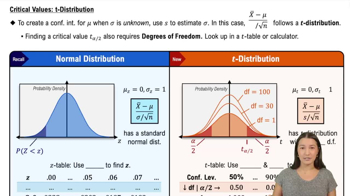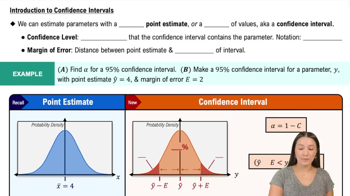Los Angeles Commute Time Listed below are 15 Los Angeles commute times (based on a sample from Data Set 31 “Commute Times” in Appendix B). Construct a 99% confidence interval estimate of the population mean. Is the confidence interval a good estimate of the population mean?
Table of contents
- 1. Intro to Stats and Collecting Data1h 14m
- 2. Describing Data with Tables and Graphs1h 55m
- 3. Describing Data Numerically2h 5m
- 4. Probability2h 16m
- 5. Binomial Distribution & Discrete Random Variables3h 6m
- 6. Normal Distribution and Continuous Random Variables2h 11m
- 7. Sampling Distributions & Confidence Intervals: Mean3h 23m
- Sampling Distribution of the Sample Mean and Central Limit Theorem19m
- Distribution of Sample Mean - Excel23m
- Introduction to Confidence Intervals15m
- Confidence Intervals for Population Mean1h 18m
- Determining the Minimum Sample Size Required12m
- Finding Probabilities and T Critical Values - Excel28m
- Confidence Intervals for Population Means - Excel25m
- 8. Sampling Distributions & Confidence Intervals: Proportion1h 12m
- 9. Hypothesis Testing for One Sample3h 29m
- 10. Hypothesis Testing for Two Samples4h 50m
- Two Proportions1h 13m
- Two Proportions Hypothesis Test - Excel28m
- Two Means - Unknown, Unequal Variance1h 3m
- Two Means - Unknown Variances Hypothesis Test - Excel12m
- Two Means - Unknown, Equal Variance15m
- Two Means - Unknown, Equal Variances Hypothesis Test - Excel9m
- Two Means - Known Variance12m
- Two Means - Sigma Known Hypothesis Test - Excel21m
- Two Means - Matched Pairs (Dependent Samples)42m
- Matched Pairs Hypothesis Test - Excel12m
- 11. Correlation1h 6m
- 12. Regression1h 50m
- 13. Chi-Square Tests & Goodness of Fit1h 57m
- 14. ANOVA1h 57m
7. Sampling Distributions & Confidence Intervals: Mean
Confidence Intervals for Population Mean
Problem 7.CQQ.7
Textbook Question
Requirements A construction quality control analyst has collected a random sample of six concrete road barriers, and she plans to weigh each of them and construct a 95% confidence interval estimate of the mean weight of all such barriers. What requirements must be satisfied in order to construct the confidence interval with the method from Section 7-2 that uses the t distribution?
 Verified step by step guidance
Verified step by step guidance1
Verify that the sample is a simple random sample. This means the six concrete road barriers must have been selected randomly from the population of all such barriers, ensuring that each barrier had an equal chance of being included in the sample.
Check that the population of weights of all concrete road barriers is approximately normally distributed. If the population distribution is not known, this assumption can be relaxed if the sample size is sufficiently large (typically n > 30), but since the sample size here is only 6, normality is important.
Ensure that the sample size is small relative to the population size. Specifically, the sample size (n = 6) should not exceed 5% of the total population of concrete road barriers. This ensures independence between sampled observations.
Confirm that the population standard deviation is unknown. The t-distribution method is used when the population standard deviation is not known, and the sample standard deviation is used as an estimate.
Verify that the data does not contain significant outliers. Outliers can heavily influence the mean and standard deviation, which would affect the accuracy of the confidence interval. Use visual tools like boxplots or statistical tests to check for outliers.
 Verified video answer for a similar problem:
Verified video answer for a similar problem:This video solution was recommended by our tutors as helpful for the problem above
Video duration:
2mPlay a video:
Was this helpful?
Key Concepts
Here are the essential concepts you must grasp in order to answer the question correctly.
Random Sampling
Random sampling is a fundamental concept in statistics that ensures each member of a population has an equal chance of being selected. This method helps to eliminate bias and allows for the generalization of results from the sample to the entire population. In the context of the question, the analyst's use of a random sample of six concrete road barriers is crucial for the validity of the confidence interval.
Recommended video:

Sampling Distribution of Sample Proportion
t Distribution
The t distribution is a type of probability distribution that is used when estimating population parameters when the sample size is small (typically less than 30) and the population standard deviation is unknown. It is similar to the normal distribution but has heavier tails, which accounts for the increased variability expected in smaller samples. The use of the t distribution is essential for constructing confidence intervals in this scenario.
Recommended video:

Critical Values: t-Distribution
Confidence Interval
A confidence interval is a range of values, derived from a sample, that is likely to contain the population parameter with a specified level of confidence, such as 95%. It provides an estimate of uncertainty around the sample mean and is calculated using the sample mean, the t statistic, and the standard error. Understanding how to construct and interpret confidence intervals is key to making inferences about the population based on sample data.
Recommended video:

Introduction to Confidence Intervals

 4:48m
4:48mWatch next
Master Population Standard Deviation Known with a bite sized video explanation from Patrick
Start learningRelated Videos
Related Practice
Textbook Question
